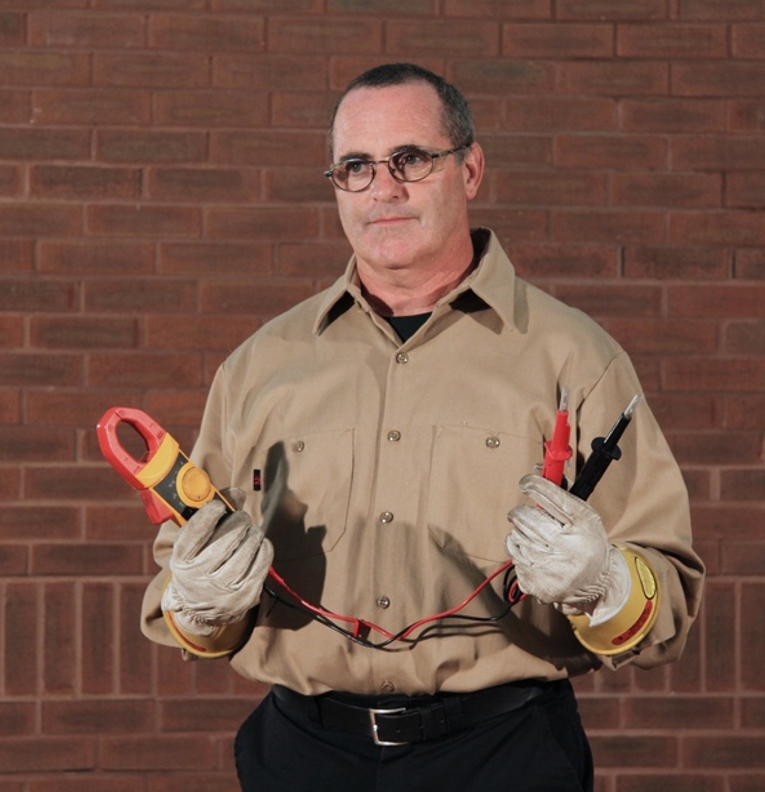
Features
Articles
How do I work safely? Setting electrical safety priorities for service contractors
March 14, 2017 | By Ron Bergeron
 Photo 1 Photos courtesy Bergeron Electric, © IEEE.
Photo 1 Photos courtesy Bergeron Electric, © IEEE.March 14, 2017 – Contractors face many difficulties when making safety practical for service electricians. All work involves risk. Well-intentioned rules and regulations do not necessarily translate as practical on a job.
I’ve identified 5 barriers that limit the application of the many rules and regulations in our industry:
1. Electricity is not dangerous
This notion is pervasive, and it undermines electrical safety. Unlike gas, there seem to be little fear of electricity. This undue comfort is reinforced by the retailer mantra “You can do it”.
2. Double-standard in government regulations
In Ontario, everyone is allowed to do electrical work in their own home. As well, the province has over 300,000 employers in over 500,000 facilities. They can all designate— to their own interpretation of “competent worker”—any of their over four million employees to do electrical work.
Service contractors, meantime, are subject to compliance through strict enforcement by licensing and inspection by some 166 Electrical Safety Authority (ESA) inspectors and 116 Ministry of Labour (MoL) construction inspectors.
Electricians ask “Why do I have to follow all these rules when janitors are allowed to do this work?”.
3. Client priorities
Clients have the same mindset as everyone else: electricity is not dangerous. They want the work done quickly and at the lowest cost. To them, it’s only about fixing what’s broken. It is not uncommon to work on electrical switchgear that’s been untouched for 30 years. There are no drawings and no labels, much less arc flash analyses.
Here’s the reality: when a contractor refuses the work, a willing contractor (or plant employee) will be found. We have lost clients because of refusing to work live, without permits, or to connect unapproved equipment.
4.(Too) many rules; limited resources
A 2013 ESA survey shows that, of some 7500 licensed electrical contractors in Ontario, 86% have fewer than 10 employees. Obviously, these outfits cannot afford dedicated support staff, yet the contractor is swamped with information and rules, from numerous sources, such as: Ontario Electrical Safety Code (OESC); Confined Spaces; Fire Code; WHMIS; Privacy Act; WSIB, and so on. The service electrician also has to know all the safety policies of each customer: in one chemical plant we service, the safety policy binder is an inch thick.
5. Traits of service electricians
Electricians are hands-on, visual learners. Perhaps the biggest hurdle to changing their mentality is many of them have 10, 20, 30 years of trade experience and nothing has ever happened to them.
Unlearning old habits takes a long time. A contractor cannot simply hand out a 100-page binder of rules and regulations and insist/expect his electricians to read and use them.
Changing the safety culture
Meeting all safety regulations is overwhelming, impractical and costly. Some contractors don’t even bother. Short of closing shop, the only practical alternative for the conscientious contractor is to minimize risk.
This means setting priorities, because resources are limited, then making safety simple and practical. Electricians will learn and apply safety information only when:
• It is concise.
• It offers concrete examples relating to fieldwork.
• The personal protective equipment (PPE) is practical and easy to use.
• The information is repeated.
The importance of electrical safety becomes relevant only when electricians realize:
• There is no cure for electrocution.
• Electrical injury impacts not only them, but their loved ones.
After over 45 years of observing the world of the service contractors across the province — my team and I have come up with a practical safety approach that we use at our firm to advance a culture of safety and minimize risk. We look at:
A. Policies
B. Personal protective equipment
C. Simplified tables
D. Knowledge
A. Policies
Risk Assessment is the first priority on any site. CSA Z462-15 focuses on electrical, but there are many other risks.
Ontario data for 2013 shows 73% of jobsite injuries are strains, fractures, cuts, bruises and pain. Only 0.1% are electrocution and 0.1% are electrical burns. That said, when something goes wrong in electrical, 25% of incidents result in death or critical injury. Considering all the data and situations, we developed and continue to modify a Daily Safety Plan form for field use.
From the vast array of electrical safety information, we prioritized our three most-important policies. Why three? To make it simple to Learn, to Repeat and to Check. (Making things simple actually takes a very long time!) The benefit is that our electricians learn and apply that safety knowledge.
1. No live work. Three exceptions: breaker/switch operation, cover removal, diagnostics.
2. Establish safe work conditions. Three basics: disconnect all energy, lockout/tagout, test to confirm. (Confirmation is crucial. Handles may move. At times, one or more blades do not!)
3. Use your PPE. In particular: voltage-rated gloves, Cat III testers, fused leads (50KA min.).
B. Personal protective equipment (PPE)
Selective PPE minimizes jobsite decision-making. When arc flash is mentioned, electricians think about guys in full flash suits (Photo 2), which they see as highly impractical for everyday use. They don’t realize the suit is only very rarely required.
Photo 1 shows an electrician prepping for diagnostics with gloves, Cat III tester and fused leads. He wears what is required for a lot of our work, which has no Category rating: safety glasses, Category 2 shirt and pants (assuming non-melting clothing underneath) and safety boots. The only difference from what he normally uses is the Category 2 clothing. (This is about 50% more than the cost of normal workwear). The balance of our work is Category 2 or lower.
The barricade tape we use is very specific yet readily available. It is yellow, not red. The tape clearly states: CAUTION: DO NOT ENTER. In my opinion, the tape is the most underrated part of PPE. It is pivotal for establishing the correct mindset, and a physical affirmation of safety. The electrician who uses the tape usually follows all safety procedures.
I tell our electricians: “Be a lion. Mark your turf”.
When the tape is not set, other people will come by to see what is going on. They will interrupt and distract the electrician. When the tape set, this rarely happens. Those most likely to ignore the tape are managers wearing crisp, flammable clothing. Electricians are instructed to be polite, but firm and clear: “Please return behind the tape. If something goes wrong here, you could die”.
As for cost, it’s $950 to equip each person with five shirts, three pairs of pants, coveralls, a face shield kit and tape. The upkeep is $300 per year.
C. Simplified tables
Another example of keeping things simple is the 1-sheet grid we created regarding shock and burn hazards (Table 1). We use this for jobsites where there is no arc flash data… which is virtually all sites!
Infused with CSA Z462-15 and OHSA—plus our best judgment—Table 1 summarizes our interpretation of regulations concerning work permitted. It took several feedback sessions with electricians to ensure the table made sense and was easy for everyone to use.
The work permitted is shown on the vertical axis. Most of the time, our electricians perform only the first three items. When they encounter the last two, they call in our specialists: two are trained in applying safety grounds, and one is trained in thermography.
Gloves… electricians do not like wearing them. They’re “too clumsy”, and there’s a perception that gloves are to be worn all the time. In the three most-common work situations, gloves are required in two cases: removing covers and diagnostics.
Going to the horizontal axis, the electrician first checks whether the system is AC or DC. (We have not yet encountered DC situations, but have the data from Z462-15.) For AC, the electrician next determines the voltage. The left-hand column shows no hazard at 50V or less. However, a shock is possible.
There are three indicators for electricians. It is easiest when the KA rating is known, but it is often unclear. The amps and KVA help with identification (KVA calculations are based on 4% impedance).
The second column from the left shows when there is no threat of arc flash, namely ≤250V <125 KVA. However, nasty arcing of up to 8KA and electrocution are possible.
Electricians are to wear the basics (Table 2). All the other situations are based on ≤600V 65 KA @ 2 cycles. We do not consider the option of lesser PPE when it comes to current-limiting devices at 200A or less. To be practical in cost and procedure, we use only Cat 2 & 4 raising the standard from Cat 1 & 3, respectively. For consistency, we “massaged” the calorie values.
In our area, the local utility voltage is 12.47kV. In the six arc flash studies we have done, none exceeded Category 2. Regarding barricades, the arc flash boundaries exceed other boundaries for Category 2 in AC and DC. These boundaries are 5 ft and 4 ft, respectively. We selected 5 ft at 600V or less. For the HV category, no distances calculated exceeded 20 ft.
When the Category from Table 1 is known, the page is flipped to Table 2, which also reminds of the Basics. In all arc flash categories, basic gear and earplugs are common. Since the electrician already wears Category 2 clothing, the only additional requirement is the combination hardhat, balaclava and face shield.(Photo 3).
Simplicity is key. The electrician has only one decision to make: Put on the face shield kit or not. Our policy is: When in doubt, wear the kit. (No one likes wearing the balaclava.) The kit is in a portable, durable case. It includes arc-rated coveralls for calorie readings of 8 to 12; as a bonus, they act as padding when service vans bounce from one site to another.
The Category 4 flash suit is a “steam bath”, but a fan in the hood helps. Procedure is paramount. The flash suit is worn only for 5-10 minutes, then removed to allow for a cool-down period of 5-10 minutes. Special cooling gear is available for up to 30 minutes of wear.
Disconnects and breakers can be turned ON /OFF without PPE under specific conditions listed in Z462. It takes training to know this. Note: These simplified tables are given to electricians after they have completed all safety training on policies, PPE and knowledge, and get a full day of training on arc flash. Yes, a full day.
D. Knowledge
The bulk of safety knowledge is presented during one-hour meetings every two months. Topics covered include fall protection, vehicle safety, static grounding and Code bulletins (among others). The information given is supported by courses such as First Aid, Lockout/Tagout, Working at Heights , Defensive Driving, to name a few.
Every month, we have a 45-minute breakfast meeting where we share safety experiences and examine equipment. For example, using checklists, colleagues inspect each other’s voltage-rated gloves.
Finally, random field visits are conducted monthly by an independent third party; they check housekeeping, inspect scissor lifts, fire prevention, etc., to confirm knowledge is being applied.
Knowledge is also enhanced electronically. All technicians can access the company server to check the OESC, Fire Code, etc. They have also been issued iPhones for greater efficiency. Our arc flash charts are in iBooks.
We do not instruct anyone on obtaining “Energized electrical work permits”. We do not work live. We have yet to encounter a situation where there is no other option.
It is important that electricians know what they can do, but it is just as important they recognize what they cannot do, and call for assistance when required. Brains trump macho.
Prioritize to survive
Prioritization is the only way to survive for the service contractor. He must inform, train and supervise to ensure the job gets done safely—all while meeting customer needs. The authors of safety rules and regulations strive for the ideal. Implicit in this approach is that everyone will understand the danger and will have vast resources at their disposal to implement the ideal. Reality paints a different picture.
In his article, “Managing Risk in the Public Interest” (June 2010), Dr. Nathwani from the University of Waterloo’s Faculty of Engineering summarizes our reality:
The focus is not on risks as such… but on what can be done practically about the efforts required to reduce risk, given available resources.
There is no absolute safety: whether it’s cooking, driving, or working, all activities involve risk. It can be minimized with good standards and practices, and setting priorities. Service contractors face economic pressures and challenges in the field. That is why safety must be simple to do and easy to manage.
* This article also appears in the March 2017 edition of Electrical Business Magazine. Check out our ARCHIVE page for back issues.
A regular contributor to Electrical Business Magazine, Ron Bergeron is a master electrician, professional engineer since 1969 and an electrical contractor since 1971. He was also involved with Ontario’s Electrical Safety Authority as a member of the Industry Advisory Council, Fee Restructuring Committee and Contractor Advisory Council. He is currently on the Board of the Ontario Electrical League and a Council member of the Electrical Contractor Registration Agency for Ontario. He can be reached at ronb@bergeronelectric.com. This article is based on a paper presented at the IEEE Industry Application Society’s Electrical Safety Workshop (ESW) in Toronto, Ont., January 2011.
Print this page





